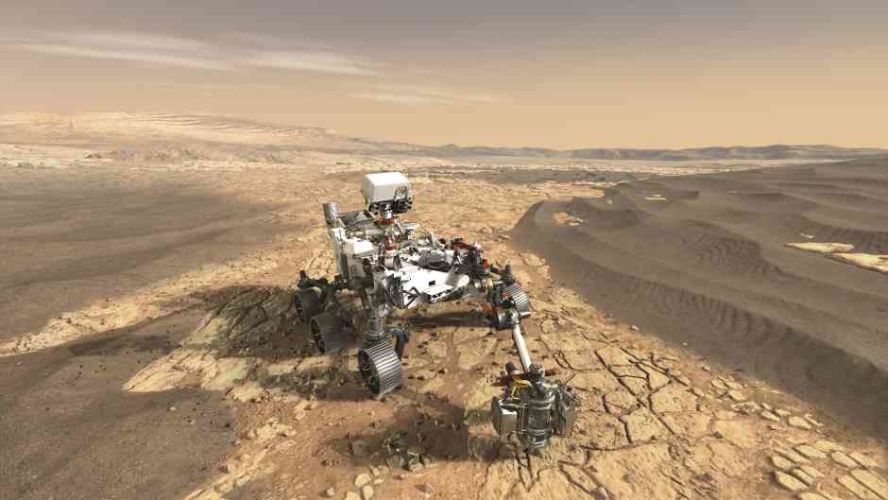 NASA’s Mars Perseverance mission is the perfect blend of geology, aerospace, and Internet of Things technologies, says Paul Kostek, IEEE senior member and advisory systems engineer at Base2 solutions.
NASA’s Mars Perseverance mission is the perfect blend of geology, aerospace, and Internet of Things technologies, says Paul Kostek, IEEE senior member and advisory systems engineer at Base2 solutions.
The National Aeronautics and Space Administration (NASA) launched its Mars 2020 Perseverance rover on the 30th July, with the mission of searching for signs of ancient life and to collect rock and soil samples for possible return to Earth. With NASA’s goal to understand if microbial life was once present on the planet, Perseverance must be equipped with the latest technology to make its mission a success. Indeed, once it touches down in 2021, Perseverance must survive the harsh climate of Mars and search for signs of life. As the world watches on, the technology onboard this rover has never been more important and potentially life changing for those waiting for news back on earth.
Mars 2020 mission gears up for a red planet return
UK scientists join NASA in search for life on Mars
There are several different ways in which this mission will help pave the way for future human expeditions on Mars and demonstrate technologies which may also be used in the future. This includes testing a new method for producing oxygen from the Martian atmosphere, improving landing techniques, as well as analysing weather and other conditions that could affect other missions to Mars. In fact, the Perseverance rover will be using the same technology that is used for self-driving cars on Earth – in other words, it will use autonomous technology. With more self-driving capabilities, Perseverance will be able to cover more ground in a day’s operations, making space exploration more efficient for another spacecraft. This is made possible through machine learning algorithms and sensors that make it possible to get it through difficult terrains.
When it comes to the terrain, Perseverance is on the surface of Mars to collect rock and soil samples, and then deposit them on the surface for pickup by a future mission to return them to earth for examination. To search for microbial life, it will be using laser technology to examine rock and soils. From just feet away, it can fire a laser to study rock targets smaller than a pencil point, according to new details released by NASA. The laser technology can now provide imaging, chemical composition analysis, and mineralogy. This means that Perseverance can study spots it cannot reach with its arm and examine new materials it physically cannot reach. This laser is also helpful because it clears dust and helps the sensors to get clearer views of targets and acquire more accurate data.
NASA will also be using an autonomous helicopter and drone technology. Its autonomous helicopter, named ‘Ingenuity,’ is the size of a shoebox and is bolted to the Rover’s undercarriage. Once the rover has landed on Mars, it will become the first aircraft to make a powered flight on another planet.
"However, this is no easy task, as flying a drone on Mars is going to be a challenge, due to the harsh climate and thin air – the atmosphere on Mars is 99% less dense than earth. Ingenuity will also be exposed to severe cold (-130F/-90 C). Testing has been done to simulate both conditions on earth but the actual environment will stress the components to their limits.”

Robotics will also play a role in the Perseverance mission. With a long robotic arm, Perseverance will be able to gather samples and data. Similar to a human arm, Perseverance can use tools to help extract cores from rocks, take images, and analyse the rocks and soil. The hand, or “turret”, as it is formally known, will be capable of carrying scientific cameras and even has a special sensor to protect the robot from incorrectly contacting the surface to reduce the chance of damage. The rover's drill will use rotary motion with or without percussion to penetrate the Martian surface to collect the precious samples. The drill is equipped with three different kinds of attachments that allow sample collection and surface analysis.
Like never before, the Perseverance rover mission will also be livestreamed, providing people with real-time access to science and technology in action. Indeed, the spacecraft and robot features 23 cameras, which is more than any interplanetary mission in history has ever carried. Once Perseverance drops down on Mars in early 2021, the cameras will help engineers and researchers understand the landscape of an unknown and – until now – unexplored world.
Ultimately, this new mission is the perfect blend of geology, aerospace, and Internet of Things (IoT) technologies. Perseverance is the result of the work of teams of engineers and scientists addressing a range of fields. It provides another opportunity for the public to learn more about technology and about Mars. Once landed, it will provide engineers and scientists an opportunity to learn more about Mars and prepare for future missions, including the goal of manned missions.
Paul Kostek is an IEEE senior member and advisory systems engineer at Base2 solutions










UK Enters ‘Golden Age of Nuclear’
The delay (nearly 8 years) in getting approval for the Rolls-Royce SMR is most worrying. Signifies a torpid and expensive system that is quite onerous...